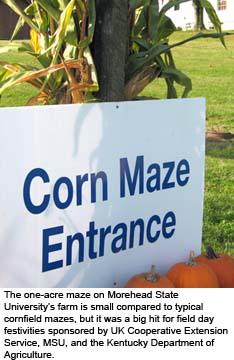Cornfield Mazes Help Bring Fun to the Farm
Cornfield Mazes Help Bring Fun to the Farm

A one-acre cornfield located north of Morehead is yielding a lot more than corn. It’s also giving ground to good, old-fashioned fun.
This carefully manicured cornfield has been turned into a maze, a bigger-than-life puzzle that people solve as they navigate their way from beginning to end. It was one of the highlights recently at the “Your Farm, Your Family, Your Future” field day sponsored by the University of Kentucky Cooperative Extension Service, Morehead State University and the Kentucky Department of Agriculture at MSU’s farm.
“Are you ready to be a-maze-d,” joked UK Extension Agricultural Engineer Tim Stombaugh as a group of field day participants stopped to check out the demonstration maze.
Despite its triteness, amazing might well describe this and other cornfield mazes that have been popping up around the country in recent years. But it’s not only because of the fun associated with trying to wend your way through a maze’s oft-confusing passages. Mazes are also wowing farmers with their potential to harvest additional dollars.
“If they are done right … there’s a lot more revenue potential for this than the actual corn that you get off it. Way more,” said Stombaugh, who helped design the Morehead maze using Global Positioning System technology.
Cornfield mazes fall under the umbrella of agritourism, a term that the U.S. Department of Agriculture uses to describe enterprises that allow farmers to earn higher profits by replacing or supplementing traditional farm operations with innovative on-farm ventures. Although there’s a limited time frame for maze operations – generally September and October – the potential to realize additional profits from a plot of corn is great.
“You’re adding value to that land. You’re still getting some corn, maybe not as much value for the corn, but you have this other value of the people that have been there and gone through the maze,” Stombaugh said.
Cornfield mazes also have the potential to call attention to the value of farms and the role of agriculture in American society, which according to Brent Frazier, program coordinator
for the Kentucky Department of Agriculture’s division of farmland preservation, has become increasingly important in recent years. “It’s just a way to bring people back to the farm and let them see how things are grown and see the fun that can be had on the farm,” said Frazier, who was on hand at field day to talk about agritourism in Kentucky. “It’s getting back to something that a lot of people don’t get a chance to enjoy because they are so many generations removed from the farm. We believe it’s real important to get those people to come back.”
“It’s just a way to bring people back to the farm and let them see how things are grown and see the fun that can be had on the farm,” said Frazier, who was on hand at field day to talk about agritourism in Kentucky. “It’s getting back to something that a lot of people don’t get a chance to enjoy because they are so many generations removed from the farm. We believe it’s real important to get those people to come back.”
Aside from the profit and public relations potential of corn mazes, they can be relatively easy and inexpensive to create – especially when GPS technology is used, Stombaugh said.
“Essentially, we started from a concept, which was almost a hand-drawn sketch of the field and what we wanted the maze to look like,” he said. “We took the sketch and put geographic coordinates on it and put it into the computer. Then we came out here with GPS receivers and laid out the paths along the field.”
A few computer software companies have designed GPS software with the functionality that allows people to do such things as design corn mazes. Stombaugh used a “high-end” version, but less expensive ones are available, he said.
“The software is not terribly expensive, and actually the GPS equipment – the equipment you’d want to use for this – you can go out and rent it from companies, so you won’t need to purchase that equipment,” he said.
Constructing a maze, once it’s designed, can also be an easy proposition. Corn is planted with rows 30 inches apart and then planted again, crosswise, to provide density. When the plants reach a height of 6 to 8 inches, the passageways are cut down, usually with a mower or weed trimmer.
Cornfield mazes, which typically range in size from four to 20 acres, may be created in a variety of shapes and designs. Some are so intricate that they take hours to maneuver. They are most successful when they are located near urban areas, Stombaugh said.
“They’re becoming more popular where you have the urban and rural interface, where the cities are growing … and people from the towns want to get out into the country on the weekend and do something,” he said.